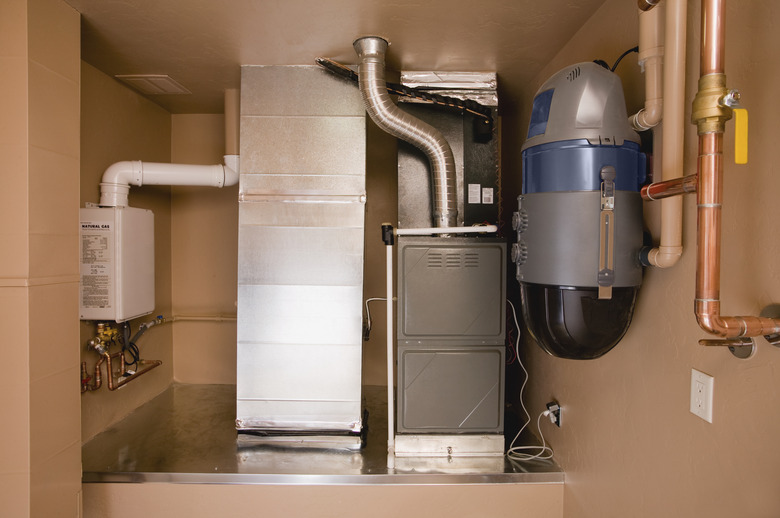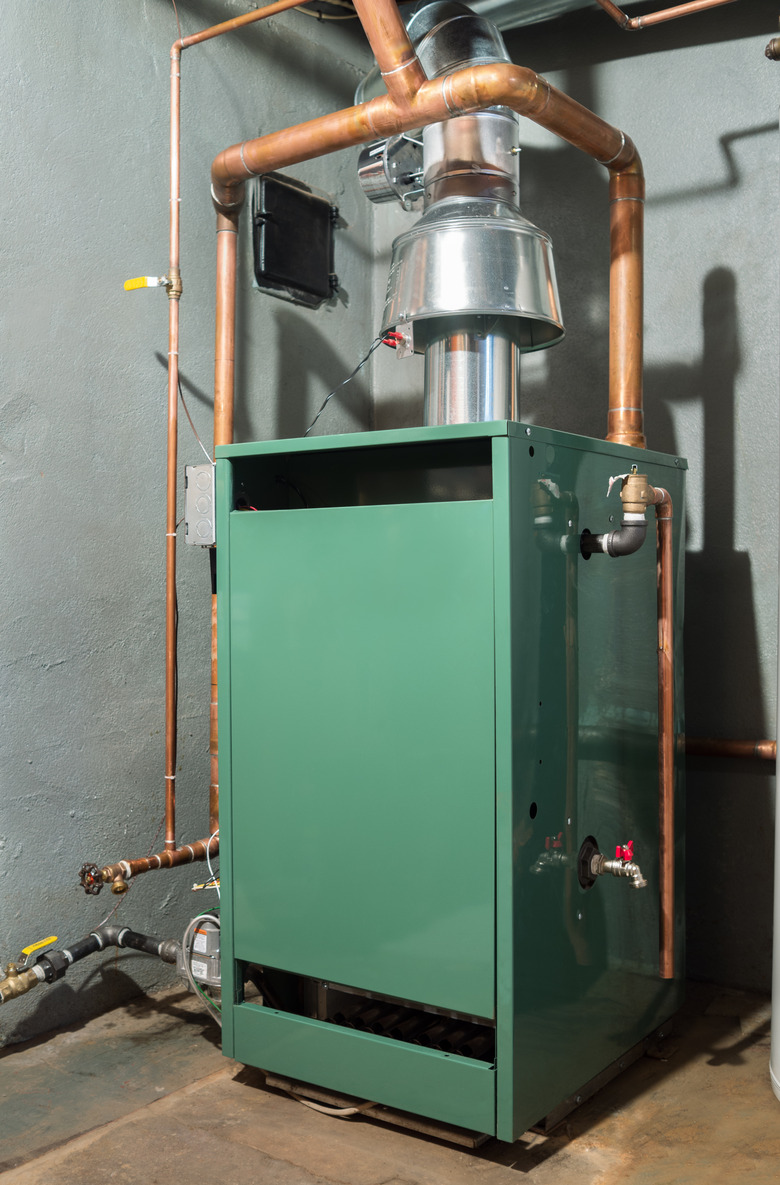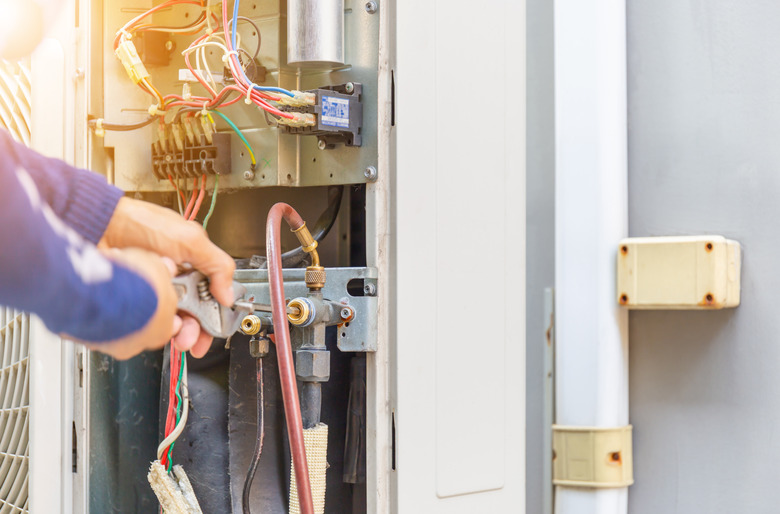What Is A High-Efficiency Furnace?
High-efficiency furnaces are for homeowners who are interested in saving money on energy bills and increasing their home's heating efficiency — and who don't mind spending some money on it upfront. The annual fuel utilization efficiency (AFUE) rating of a standard-efficiency furnace is 80, meaning that 20 percent of the heat they produce is wasted, and the AFUE rating of older furnaces can be in the 60s.
By contrast, many high-efficiency furnaces have ratings in the 90s — some as high as 97. That means that virtually all the heat produced by a high-efficiency furnace goes to heating your home, not the outside air. That's bad news for birds and small animals who gather around heating vents for warmth, but it's good news for your bank account.
High-efficiency furnaces aren't right for every home. The cost of installing one is about double the cost of installing a standard-efficiency model, and although you might make up the difference in energy savings over time, it may take a while. Nevertheless, you're doing your part to conserve energy by switching to a high-efficiency furnace, and some northern communities with cold winters require them. If you're considering purchasing a new furnace and you're put off by the higher price tag of a high-efficiency model but want to keep your fuel wastage to a minimum, it's good to know that there are ways to make a standard-efficiency furnace more energy efficient.
Tip
A high-efficiency furnace is by definition one with an AFUE rating of 90 or higher. What makes it more efficient than a standard furnace is a secondary heat exchanger. It condenses the exhaust gases into a liquid, thus extracting extra heat and making it available for circulation.
How High-Efficiency Furnaces Work
How High-Efficiency Furnaces Work
Like those in a standard gas furnace, the burners in a high-efficiency furnace are enclosed in a metal housing called a heat exchanger, and as the fuel burns, the metal heats up, and the furnace blower circulates the heated air throughout the house. The difference in furnace design that makes the big difference in energy efficiency is in what happens to the exhaust gases produced by combustion.
A standard furnace is designed to vent these gases through the roof and outside the home, but the high-efficiency design calls for a second heat exchanger in which these gases collect and condense into a liquid, releasing virtually all the heat produced by combustion. For this reason, a high-efficiency furnace is also known as a condensing furnace. The condensate is basically carbonic acid, and the furnace design includes a PVC pipe to drain it into the sewer or outside the house. This pipe can't be made of metal, or the acidified water would quickly corrode it, and the drain would leak.
The design of high-efficiency furnaces also includes a pipe to vent exhaust gases, and because all the heat has been removed, this pipe can also be PVC. For the condensing process to take place, the entire furnace must be in a sealed combustion chamber, so a second PVC pipe is needed to draw in combustion air from outside. Most designs incorporate a concentric PVC pipe that doubles as an intake and exhaust vent.
Is a High-Efficiency Furnace Worth It?
Is a High-Efficiency Furnace Worth It?
When buying a new car, most people choose one according to their needs, and the same is true for furnaces. Local climatic conditions are probably the number one factor to consider. People living in southern regions don't need the same amount of heating as those in northern ones, and for them, a heat pump system, which can do double duty as an air conditioner, is probably a more practical option. Even a midefficiency gas furnace is more practical given that it costs less to install ($1,500 to $2,500) than a high-efficiency model ($3,000 to $5,000), and it won't be used as often as it would be in northern regions.
The placement of the furnace in the home is another important factor. If you're replacing a furnace in a basement or crawl space with plenty of ventilation, there is already adequate airflow for a midefficiency model. Installing all the drains and vents for a high-efficiency model would be like buying a Lamborghini for doing your regular shopping trips when a Honda, which may not have all the same bells and whistles, will do the job just as well for a lot less money. On the other hand, the furnace room may be a small room in the middle of the house and may have no air circulation, in which case a sealed furnace that draws in air from outside would be a better and safer choice.
When High-Efficiency Furnaces Make Sense
When High-Efficiency Furnaces Make Sense
The Department of Energy acknowledges that high-efficiency furnaces save money on energy bills over their service life, but whether or not this is enough to offset the higher cost of purchase and installation depends on how long you plan to live in your home. A high-efficiency furnace is a good investment if you're living in your forever home, but if you have plans to move or you could be relocated for work, it might not be the best choice.
On the other hand, many states and utility companies offer tax credits and incentives for homeowners who install a high-efficiency furnace, and these may sufficiently offset the installation costs to make installing one cost-effective even if you aren't sure how long you're going to stay in your home.
HVAC professionals generally agree that homeowners are most likely to benefit from a high-efficiency furnace when:
- They are installing the furnace in an enclosed space without air circulation.
- The current furnace exhausts into a chimney. In this case, the PVC venting system and cool exhaust is less likely to cause chimney deterioration than a hot gas vent.
- Energy efficiency is the number-one concern.
- They live in a state that requires new furnaces to have an AFUE of at least 90. According to a Department of Energy rule adopted in 2013, that includes 30 northern states.
If you're replacing a conventional furnace in a vented area with good air circulation, most professionals agree that it's more cost effective and makes more sense to install a standard furnace. That doesn't mean you need to sacrifice improved energy efficiency. Most contemporary midefficiency furnaces are well-sealed and come with features that make them at least more efficient than the furnace being replaced if not as efficient as a condensing furnace.
Features for Enhanced Furnace Efficiency
Features for Enhanced Furnace Efficiency
No matter what type of furnace you have, it will run more efficiently if it has more than one operating mode. The burner on a two-stage furnace runs full blast only when the temperature is below a preset value that can be programmed on the thermostat. Otherwise, it burns at a cooler temperature that saves gas while heating the air more evenly. The blower can also operate at two speeds, and at the lower one, it typically runs for a longer period, which allows the filters to trap more pollutants from the air.
A variable-speed blower on a furnace or air handler is a variation on this theme that allows for even more efficient operation. It is able to monitor room temperature as well as conditions inside the ducts and the furnace itself to run the blower at the optimum speed. A variable-speed blower provides better temperature and humidity control than a single-speed model, and it makes less noise, all while using less energy.
Furnace ignition systems also contribute to efficiency. The standing pilot light, which is a small flame kept constantly burning, is the original gas ignition system, but it's also the most wasteful and least dependable. It depends on an electrical signal from a thermocouple to keep the gas valve open, and thermocouples regularly fail. Most contemporary furnaces have pilotless ignitors, the most common being hot surface ignitors. They are electric heating elements that come on only when the thermostat calls for heat and shut off once the burners ignite, while a flame sensor does the job of the thermocouple and shuts off the gas if the ignitor fails to ignite the gas.
Installation Considerations for Condensing Furnaces
Installation Considerations for Condensing Furnaces
If you're considering a high-efficiency furnace, you'll want to know what's involved with installation, and you are well-advised to shop around for a reputable installer. The National Institute of Standards and Technology states that improper installation can bump up your heating costs by as much as 30 percent, completely negating the efficiency advantage of the furnace. Leaking and improperly sized ducts are the most common installation errors, so a thorough examination and evaluation of your duct system is an essential prerequisite to installation.
You'll need to install air intake/exhaust vents, and these are usually routed through a sidewall. Most of the furnace exhaust turns into a liquid, which drains through another horizontal pipe that runs from a drain pan underneath the furnace through a sidewall or into the home's drain system. Whatever gases are left over after the bulk of the combustion gases in the secondary heat exchanger condense are already cool, but they still have to be vented, and some condense inside the vents. It's important for the vent pipes to have a slope back to the furnace to allow this condensate to enter the furnace drain.
One serious mistake homeowners can make is to choose the wrong size of furnace for their square footage. An undersized furnace will run continuously and fail to keep the house warm, and that wastes energy. An oversized furnace also wastes energy by cycling on and off too often. The optimum furnace size depends on a number of factors, including the climate zone, the size of the house and the size of the ducts. The calculations call for specialized measuring equipment and should be done by an HVAC specialist.
High-Efficiency Furnace Maintenance
High-Efficiency Furnace Maintenance
A high-efficiency furnace requires the same maintenance as a standard furnace and even a little more. It's important for the vents to remain unblocked, so the vent openings, which are near the ground and accessible to insects and small animals, have to be checked regularly. The drain also must remain unobstructed, so if it exits through the wall, it should be checked along with the vent.
As with any furnace, it's important to change the filters regularly every three months during heating season and, if your heating system includes air conditioning, during the cooling season as well. If you have washable filters, you should clean them every three months. Dirty vents restrict airflow, and while that won't affect the furnace's supply of combustion air, it will force the furnace to work harder to push heated air through the vents.
Homeowners can handle many of the small furnace problems themselves, but they should plan on having the furnace tuned up by an HVAC technician once a year. During the furnace tune-up, the technician will check the furnace drain pan and clear it if necessary and inspect the heat exchangers for cracks. The secondary heat exchanger sometimes gets blocked, and that can occur for a number of reasons. Some, such as accumulation of soot caused by a burner malfunction, point to other defects that must be addressed.
References
- HomeServe: Need a New Furnace? Here's What You Should Know
- Goodman Air Conditioning & Heating: Is a High-Efficiency Furnace Right for Me?
- PV Heating & Air: The Great 80% Vs. 95% Furnace Showdown
- Hannabery HVAC: Frequently Asked HVAC Questions
- National Institute of Standards and Technology: Underperforming? Energy Efficiency of HVAC Equipment Suffers Due to Poor Installation
- Every CSR Report.com: Energy Efficiency: DOE's Regional Standards for Indoor (Non-Weatherized) Residential Gas Furnaces


